Palau
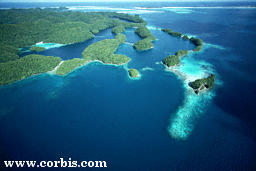 |
The warm waters of Palau, a small archipelago in the Pacific Ocean, hold perhaps the richest and most biologically diverse coral reefs on the planet. In this "cradle of diversity," marine biologists have recorded 700 species of corals and 1,500 species of fish.
Palau's coral reefs began to grow millions of years ago when coral polyps colonized submerged volcanic mountains. The tiny polyps produced a material that cemented them in place. Side by side, they built hard, external skeletons around their soft bodies, and when they died, other corals built skeletons on top of them. Geologic forces eventually raised the coral topped mountains above the sea, and all the exposed corals died. In time, new colonies built more reefs on the islands undersea slopes.
Today, divers swimming over the coral gardens of Ngemelis Island are moved by nature's artistry and creativity. The top of this reef, just a few feet below the surface, resembles wild flowers swaying in the breeze. Here, soft coral trees and bushes seem to have been painted in stunning shades of green, red, yellow, and orange.
Among the many fish species fluttering around gracefully are yellow butterflyfish, blue-headed wrasses, and emperor angelfish-black masked and striped. Not so graceful, though, is the mango-size puffer, a fish that sucks in water when startled and inflates its body to the size of a football. Sharp spikes stick out in all directions and are quite a deterrent to potential predators. Another cumbersome swimmer is the pear-sized trunkfish, whose tough, trunklike body is difficult for predators to chew.
Nestled among the Ngemelis corals are giant clams. These two- or three-foot-long creatures, depicted in early movies as being able to grab divers' feet, feed harmlessly on plankton-not divers. And poking ever so slightly out of cracks in the corals are green and red brittle stars. Related to sea stars, these animals grow arms that break off easily if bitten by predators or touched by scuba divers. Brittle stars hide until sundown, but at night they crawl out, spread their arms, and feed on plankton.
Sometimes the best way to observe fish is to find a sandy patch, settle down, and wait, letting them get accustomed to you. And a good technique for finding a particular kind of fish is to look from right to left, rather than left to right-the usual way in which people view things. Looking in this manner slows down the viewing process and increases the odds of sighting an animal.
Not difficult to spot are watermelon-size cuttlefish hovering in the water. Related to the octopus and squid, these members of the cephalopod group can change their colors, patterns, and shapes so that they sometimes look like floating plants or free-swimming octopuses, their arms tickling unseen objects. Another master at deception is the crocodilefish. A lie-in-wait predator, this three-foot-long fish has an uncanny resemblance to its reptilian namesake.
One of the greatest underwater shows on earth can be seen at Blue Corner, a part of the archipelago named for the deep blue quality of its water. Here, currents strong enough to rip the mask from a diver's face bring in a healthy supply of plankton, a food source that attracts unicornfish, tangs, and other plankton-eaters. In turn, these fish attract huge schools of predators, including sharks and jacks. The school of jacks can number 300 or 400 and be so dense that it nearly blocks the sunlight, creating the effect of an underwater eclipse. Blue Corner also attracts manta rays and eagle rays. With wingspans of several feet, these large plankton-feeders have few predators and can feed leisurely without having to worry about the ever present sharks patrolling the reef.
At Blue Corner, the currents are so fast that a diver's encounter with a pelagic fish may last only a few minutes before he or she is whisked into the open ocean. Some divers overcome the time constraints of current diving by using a reef hook, a three-foot-long line with a hook at both ends. One hook attaches to a scuba vest and the other to a nook or cranny in the reef. The hook extends the dive, but in the process of setting, adjusting, and releasing it, a diver damages the fragile corals. Healthy coral gardens are found in many other areas of Palau, but at Blue Corner major areas of coral are now barren white patches of rock. This little corner of the world shows what can happen when underwater wonders are overwhelmed by people's desire to see them at any cost.
Among Palau's other attractions are 80 marine lakes. Jellyfish lake, with its extraordinary jellyfish population, is the most visited. Like the others, it is dark green, has poor visibility, and is as warm as bathwater. Each day, jellyfish slowly follow the sun's path across the lake, soaking up sunlight for the life-supporting algae in their tissues. Because they haven't needed to protect themselves from predators, these jellyfish have lost the ability to sting. Their lake was sealed off from the open ocean eons ago, and jellyfish-eaters, such as turtles, were locked out. Without the threat of getting stung, today's underwater explorers can swim freely among yellow polka-dotted jellyfish shimmering harmlessly in the sun.The Belize Barrier Reef
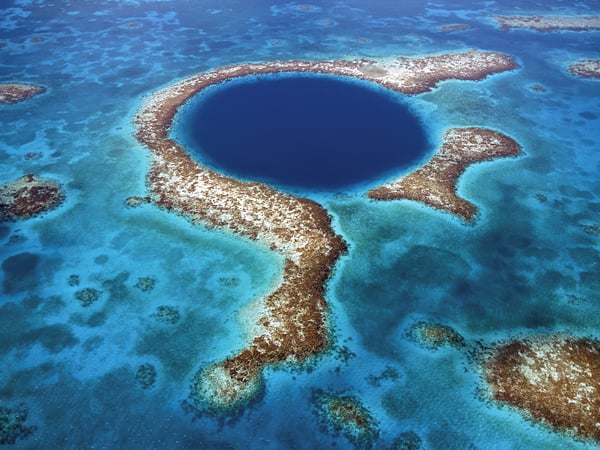 |
The second largest barrier reef in the world rises from the seafloor off the coast of Belize. A diver's paradise, it is known for fascinating coral formations, myriad fish and invertebrates, and exceptional water clarity.
On the ocean side of this 160-mile-long reef is a popular tourist designation known as Lighthouse Reef. Here, crystal-clear waters fill the famous Blue Hole, a crater more than 1,000 feet across and just over 400 feet deep. At the surface, healthy coral formations rim this wonder within a wonder, but at a depth of 125 feet, neither corals nor fish can be found. Instead, a diver finds stalactites formed during the Ice Age, when the world sea level was much lower and the Blue Hole was a subterranean cavern. The hole formed when the cavern's roof collapsed.
To the south is Glover's Reef, surrounded by waters so clear that visibility even at night is quite good: The long shaft of a diver's torch can pierce the water to a distance of 15 feet. Because it is several miles from the mainland, this reef is not affected by silt and sediment runoff. At Glover's, the arrival of a diver startles bright red cardinalfish swimming in open water, they rely on organs called lateral lines running along both sides of their bodies. A combination of sonar and radar, a lateral line senses vibrations and movements in the water, allowing fish to detect predators and pray. It's also an early warning device. As a fish swims, it creates a sort of bow wake that bounces off solid objects. When another fish feels the wake, it moves to avoid a collision.
Glover's Reef is home to the Emerald Forest, a site named for magnificent elk horn coral "trees" having trunks a foot diameter and canopies more than ten feet high. Several kinds of exotic fish also live here, and at night, a camera-bearing diver can catch them asleep, tucked in against the reef, but still out in the open. Butterflyfish as colourful as backyard butterflies hover in the water. So do hogfish with pig like snouts, trumpetfish that look like two-foot-long musical instruments, and parrotfish, their beaklike mouths closed for the night.
Not all of the reef's creatures are lost in sleep, however. Manta rays and sharks prowl the darkness, seeking meals. Lobsters, crabs, shrimp, and nudibranchs (the beautiful slugs of the sea) search the reef for food and mates. A Nassau grouper gets its mouth "cleaned" by a tiny shrimp, which darts from side to side and from top to bottom to remove small parasites and dead flesh from the cooperative fish, its mouth frozen in a wide yawn. The shrimp gets a free meal, so to speak. Dr. Mary Wicksten, a marine biologist at Texas A&M University and a specialist in these so-called cleaning stations, says that fish seek out established stations on the reef because the activity is important for their health. Like several other reef fish, the Nassau grouper is remarkable for its ability to change sex as it gets older, increasing its chances for reproductive success when another grouper is met.
At a natural cut in Glover's Reef, where water surges during the changing of the tide, a diver can free-fall horizontally, whipped along by the strong current. But fish hover without obvious effort, their streamlined bodies designed by nature to keep them in place in such conditions. Jutting from the walls of the cut, like fingers on a huge hand, are lavender tube sponges that eat by filtering tiny plants and animals from the sea. Soft coral sea fans, also filter feeders, bend in the breeze like underwater current that brings them a constant supply of food. The dominant life-form here is the hard coral, which is capable of withstanding the force of very strong wave action.
Where the current exits this canyon, it stirs up sand from the floor of a lagoon, reducing visibility. Somewhere near the bottom, turtles and manatees leisurely feed on sea grasses, while small coral heads form mini-reefs alive with tiny fish.
Across the lagoon is the Hol Chan Marine Reserve, a small area off Ambergris Cay where the tangled roots of a mangrove forest reach into the water. Even here, small fish dart among the roots, looking for meals or protection from predators.
Hol Chan, which is Maya for "the cut," was established in 1987. It encompasses all three habitats of the barrier reef ecosystem: reef, lagoon, and mangroves. Although separate, each area depends on the others. Marine scientist Jacque Carter, who has long studied Belize's fish, writes: "The mangroves are a feeding and breeding ground for reef fishes; they also trap silt and sediment runoff before it reaches the reef. The lagoon is...a feeding ground for many reef fishes, and the sea grasses...trap reef-smothering particles [keeping them] from reaching the lagoon, mangroves and shore areas from destructive wave action. If one area is damaged, the others are also affected – which is why it is important to protect the entire system, and not just the beautiful coral reef."The Galapagos Islands
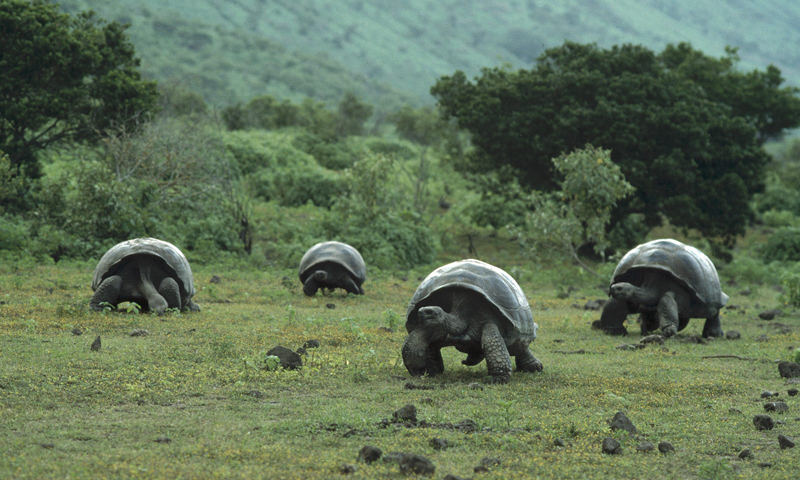 |
Rising from the Pacific 600 miles west of Ecuador are arid islands whose name, for obvious reasons, is a Spanish word for tortoises. Indeed, the Galapagos islands are famous for tortoises weighing hundreds of pounds. What many people don't know, though, is that fascinating creatures also live in an undersea realm offshore.
Describing the contrast between the islands and their underwater bounty in a the 1924 book of, Galapagos: World's End, William Beebe wrote: "Host of sally-lightfoots [tidal crabs] were the most brilliant spots of color above the water in the islands, putting to shame the dull, drab hues of the terrestrial organisms and hinting at the glories of colorful animal life beneath the surface of the sea. "
Four currents converge in Galapagos waters: the Peru or Humboldt to from the south, the Equatorial from the West, the North Equatorial, and the Panama. Fish and invertebrates from different oceans and habitat ride these currents and quickly make themselves at home along the rocky shores, on a sandy sea bottom, and in the mangrove forests of the Galapagos.
Among the most playful creatures here are the sea lions. Slicing through the water at dazzling speed, they sometimes perform an underwater ballet of sorts, twisting, turning, stretching, and arching their sleek bodies amid clouds of plankton. A sea lion will swim just inches from a diver's mask as if approaching for a kiss, or it will nibble at a swim fin or embrace the diver with its flippers, all the while maintaining eye contact-a technique that requires incredible flexibility and agility.
A sea monster the size of a school bus also lives in Galapagos waters: the whale shark. Largest fish in the sea, it eats plankton and fish strained from the water by its wide mouth. Although encounters with it are rare here, encounters with other sharks are not. Six- to eight-foot-long hammerhead sharks, with heads shaped like sledgea hammers, swim in schools of a hundred or more. White-tip, Galapagos, and bull sharks, most larger than a man, are seen by nearly every explorer who enters these waters. Getting pictures of them while diving is difficult, though, because a diver's bubbles seem to frighten them.
Among the more unlikely denizens of equatorial waters are Galapagos Penguins. Only here and along the Pacific coast of South America do Penguins live near the Equator. They ply these waters with great ease, chasing fish and avoiding sharks. Out of water, they may be seen waddling about on the islands' volcanic rocks.
Another unique animal is the marine iguana, a ferret-size lizard whose distinctly reptilian features are adaptations for its life in the Galapagos: it uses its blunt snout to scrape algae from submerged rocks, it's clawed feet to grip slippery rocks, its muscular body and tail to swim in strong tides, and its spines to defend against predators.
Although the archipelago holds many wonders, it does not have a coral reef. Instead, diver's find dramatic volcanic rock formations beneath the sea. Some of them are bare; others are covered by red algae, orange and costing sponges, orange cup corals, and bushes of black coral.
One reason for the low number of reef-building corals is a weather phenomenon called El Nino. Periodically, El Nino brings an incursion of water that is poor in nutrients and unusually warm; these conditions are unfavorable for corals and plankton. El Nino also causes rainfall to increase, and large amounts of freshwater added to seawater are detrimental to coral growth.
Conversely, these seas hold a high number of fish-300 species, of which 17 percent are endemic. Among them are the hieroglyphic hawkfish, a bottom-dweller that seems to have symbols etched on its body, and the red-lipped batfish, with fashion-model-red lips. Not surprisingly, the archipelago attracts many fishermen.
Although the area is protected by an 1986 presidential decree making it the Marine Resource Reserve, it is still the site of illegal fishing. Park rangers simply don't have the resources to patrol almost 30,000 square miles. Luckily, the conservation effort is strong, being led in part by the owner of live-aboard dive vessels, Herbert Frei, Jr., who says that a plan is in the works to provide fisherman with a livelihood, while not significantly affecting the underwater habitat.
Efforts are also under way to save the islands' terrestrial animals, especially the tortoises. Because their shells come in different sizes and shapes-domed, saddle-back, or somewhere in between-these gentle giants formerly were thought to be members of several species. In fact, there is only one species, and it was almost wiped out by hunting and habitat destruction. Today, scientists at the Charles Darwin Research Station are working to protect and, in some cases, reintroduce the giant tortoises to more remote areas of the archipelago.
Fortunately some 750,000 birds still can be found among the islands. Flycatchers, mockingbirds, yellow warblers, hawks, owls, and finches are common. So far 19 species of seabirds, including the blue-footed booby, red-footed booby, frigate bird, and the waved albatross.
When naturalized Charles Darwin first came to the Galapagos in 1835, he noticed that animals of the same species looked different on different islands. Years later, he developed a revolutionary theory of evolution and wrote On the Origin of Species by Means of Natural Selection. What might he have thought if he had also seen the remarkable creatures in the sea surrounding islands? The Northern Red Sea
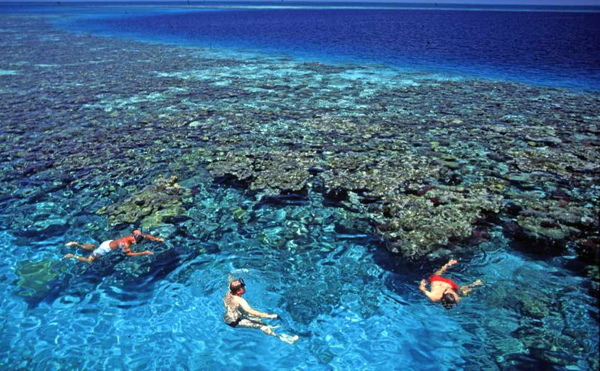
Surrounded by one of the world's largest expanses of sand, the Red Sea laps the shores of an ecosystem seemingly devoid of life. For that reason, many people find it difficult to imagine that some of the earth's richest coral reefs rise from the floor of the sea's northern reaches.
Marine scientist Eugenie Clark has no such difficulty: "If I could only dive in one place in the world, I would choose Ras Muhammad. " Having researched life in the Red Sea for more than four decades, she believes that this area best represents the Red Sea's many marine splendours. In 1980, Dr. Clark encouraged the Egyptian government to make the site a national park, an idea that became a reality in 1983.
A coral plateau in deep water, Râs Muhammad has sometimes been called an underwater Garden of Eden, a quiet place with the feel of a church. Shafts of sunlight illuminate the the reef's, yellow, orange, and light green soft corals. hard corals such as stars, fingers, and clubs are also found here, ensuring that the community is rock solid.
Some sea anemones on the reef seem to glow a brilliant shade of orange, a color that comes from algae in their tentacles. Although many photographers have tried, no one has yet been able to capture this glove on film. Now and then a diver will witness a very rare sight: bright-red lionfish swimming in open water during the day. Equipped with the venemous dorsal spines, these fish usually reside near the sea bottom, waiting to trap smaller fish in nooks and crannies.
Several divers have met "George," a reef monster the size of a beanbag chair. A humphead wrasse, this fish has chameleon eyes, cowlike lips, and a body pattern in the form of an intricate green maze on a blue background. Although George is a strange-looking creature, he is, in fact, a friendly fish seeking only hand outs from divers.
At Râs Muhammad some divers also have unforgettable encounters with the reef triggerfish. One moment this foot-long fish may be blowing water into a small hole on shallow ledge. The next instant it may be charging at full speed, its fangs bared. But two feet away, it will suddenly stop, like a flying saucer in a science fiction movie, and retreat. The triggerfish repeats this charge several times. When it no longer feels threatened, it goes about its business, perhaps tending its nest of newly laid eggs.
Another popular reef, Anemone city, boasts vast numbers of anemones. This reef is a swaying shag carpet of white and green tentacles. Darting in and out among tentacles are hundreds of clown fish, sporting upside down smiles, and a domino-fish, their black bodies dotted with white spots.
For the sport diver, Anemone city provides a great great deal of entertainment. But for marine scientists and divers who are interested in the mysteries of the sea, it is a living laboratory and a stage for observing one of the most fascinating examples of symbiosis in the marine world-the relationship between clownfish and sea anemones. A clownfish, for its part, protects an anemone not from fish that like to eat its soft tentacles. The anemone, in turn, offers a haven for the clownfish, which find safety among tentacles whose stings, for some reason, don't hurt it.
Clownfish present marine scientists with another interesting aspect of life in the sea. These fish, like many other reef fish species, are hermaphrodites: they have both male and female sex organs, although not at the same time. Such attributes increase the chance of a species' survival. If a female clownfish is eaten or dies naturally, for example, the largest juvenile turns into a breeding female.
Adventurous divers can explore caves and caverns at the site known as Fishermen's Bank. Here in the darkness, large schools of hatchet-shaped glassy sweepers swim in tight formation, fluttering their tiny fins and making swishing sounds as they sweep around divers bodies. Lionfish may swim near the ceilings of the caves, their venemous dorsal spines pointing downward toward divers' heads. In some caves, small openings in the ceilings are penetrated by dramatic shafts of light, an underwater show that frequently mesmerizes divers bold enough to swim here.
To learn why the Red Sea has such a diversity of species-one thousand species of tropical fish and four hundred species of corals-scientists have had to go a long way back in time. 30 million years ago, the Red Sea was closed at its southern end. Its northern end, however, opened into the Mediterranean Sea, allowing Atlantic species to enter and breed. About 10 million years later, shifts in the earth's tectonic plates closed the Red Sea's northern end and opened its southern one, letting in species from the Indian Ocean. The tectonic shifts had produced a sea with both Atlantic and Indo-Pacific species, although the latter now dominate.
Another reason for the diversity of marine life is the region's exceptionally clear skies. Intense sunlight provides abundant solar energy for the corals and the photo-synthesizing zooxanthellae that live inside them. The more sunlight corals get, the faster they grow. Healthy reef structures in the Red Sea have more places for fish to find food and hide from predators; hence, a healthier, more diverse fish population that is a wonder to behold. Lake Baikal
Click here to Buy Products! 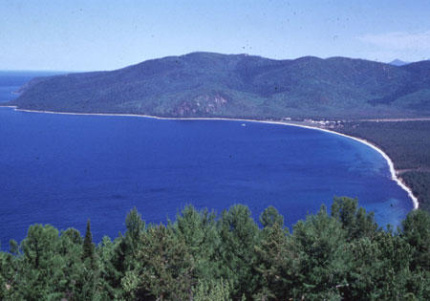 |
In early March, snow still blankets lake Baikal, its deep waters sealed beneath three-foot-thick ice. Over the next two months, under bright springtime sun, the ice will slowly thaw in a process punctuated by cracking sounds not unlike the sharp report of guns. As long as the ice remains in place, though, scientists can set up camp right in middle of this 400-mile-long, 5,000-foot-deep lake.
Russia says "Sacred lake" is 25 million years old-the oldest lake on the planet. It is also the deepest lake, holding more water than all of North America's Great Lakes combined. It's aquatic life comprises more than 1,500 animal species and 1,000 plant species, two-thirds of which are endemic. According to marine scientist Andy Rechnitzer, Baikal is more biologically diverse than other lakes because oxygen-rich water circulates from its surface to its deepest depths, a process likely related to geothermal vents.
One of the most interesting animals in the lake is the Baikal seal, or nurpa, the world's only fresh water seal. Nurpas use their sharp claws to carve dens for their families while ice is still forming. Finding their dens is relatively easy: look for air bubbles trapped in the ice after being exhaled by nurpas. You can also look for small breathing holes poked into snowdrifts by the seals.
For a diver to get into a den is another story. First, a diving crew member must use a small metal saw to cut a small hole in the ice. Then a circular, manhole-size opening is cut with a chain saw, and long poles are used to push the round slab under the ice. To keep the hole from freezing over, it must be constantly raked. A team effort, indeed. Under the ice, the water is warmer than the air [36 degrees F], but it is still very cold for scuba diving. Every 30 seconds or so, divers must tug on safety lines attached to their wrists to let the crew above know that they are all right.
Seen from an underwater perspective, the seal's den is an intricate ice carving, complete with tunnels and an igloo-like canopy that functions as an air pocket. Nurpas are shy, and pups resting on a bunk bed of ice quickly dive into the water when startled by a visitor.
In June, conditions at Lake Baikal are much different. Although the water temperature is about the same as it is in spring, the air temperature is usually in the 60s. Visibility underwater is perhaps 200 feet, many times greater than that in most lakes. The "Great vis" at that time of year is caused by the water's relative lack of minerals and by countless small crustaceans eating the algae, plankton, and bacteria that can cloud fresh water and salt water alike. Clarity does not last long, however. By mid July, an algae bloom produces pea-soup conditions.
Except for the numbing cold that pains their ears, face, and fingers within minutes of entering the water, divers exploring the shallows of Baikal might feel as if they are hovering over a meadow on a sunny day. Looking up from a depth of 50 feet, they can see clouds in the sky. Looking down, they sea fields of fluffy green algae.
The greens spires of three-foot-tall candelabra sponges poke through the algae. Such large sponges, which get their color from algae living symbiotically in their tissues, are not rare in saltwater, but in other freshwater lakes they have no parallel. The sponges are homes for amphipods, alien-looking shrimplike creatures that are as small as specks or as large as human thumbs. And the waters of Lake Baikal hold 240 species of them.
Hiding among the sponges and algae are sculpins, bottom-dwelling fish that are masters of camouflage, their patterned bodies blending in with their surroundings. These ancient fish, like most cold-water species, don't move fast; it's just too cold here to make quick moves. So, the lake's 40 species of sculpins, comprising 80 percent of Baikal's fish biomass, rely on camouflage for protection against larger fish. Pear
Near the lakes northern and, at a depth of approximately 1,350 feet, a geothermal vent provides warmth for the community of sponges, snails, worms, and fish living in the pitch-dark environment. The existence of this vent confirms that Baikal is a place where continental masses are being pulled apart. Photographer Emory Kristof, who has visited the site for the National Geographic Society, explains: "The communities of life resemble organisms normally found in an ocean, which gives weight to the theory that Baikal is an ocean in the making."
One rarely seen creature is the omul, a delicious fish endemic to the lake. Its scarcity indicates Baikal is ecologically out of balance, a result of the destructive effects of industrial development and logging nearby. Vadim Fialkov, of the lake Baikal Limnological Institute, reports that "local environmental groups have put pressure on the government to reduce the amount of effluents that are dumped into the lake. With some luck, we'll get Baikal back to its pristine state and keep it that way. "To help the effort, UNESCO has recommended that the lake and its watershed be designated a World Heritage Site." The Great Barrier Reef
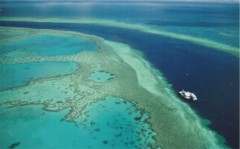 |
Spanning more than 2000 km along the northeastern coast of Australia, the Great Barrier Reef is home to thousands of species of plants and animals. The Reef which runs parallel to the Queensland coast has been designated by the Australian Government as a Marine Park.
Few can imagine the biological diversity of the reef. One probably has to realize first that the 2000 km long reef runs predominantly in the North-South direction, therefore spanning a wide range of climates. Rain forests and mountains are predominant in the northern islands, while the southern islands are composed mainly of Coral Cay.
Apart from its environmental value, the area offers visitors a variety of activities including scuba diving, snorkeling, water sports, and birdwatching.
The Deep Sea Vents
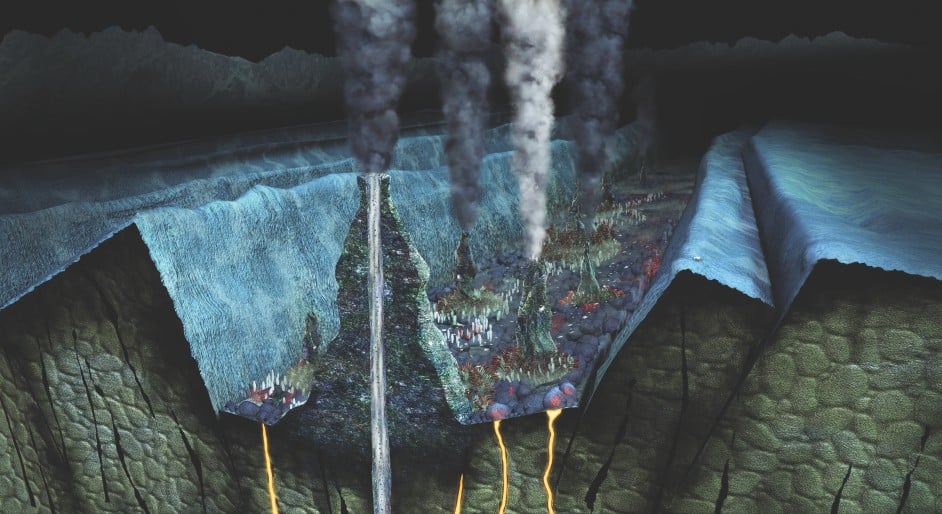 |
In the blackness of night, on a remote part of the planet, a volcano erupts. Thick plumes of what looks like black smoke billow from it. Escaping magma blankets the terrain; temperatures soar to more than 600o F. deep cracks formed around the volcano, and superheated water seeps from them.
Local residents do not evacuate the area. While the magma is fatal to them, the hot water is not, and thousands are able to thrive in a seemingly hellish habitat.
The violent eruption, which has been going on for weeks, is not typical volcanic activity. It is happening at a deep-sea vent more than 8,000 feet below the surface of the ocean.
Deep-sea vents are also known as deepwater seeps, deep-sea springs, and hydro-thermal vents. Found at the bottom of the ocean, they are created by volcanic and tectonic activity in areas where huge hostile plates are converging or spreading apart. Magma erupts along the margins of these plates, usually slowly, but sometimes with such ferocity that it creates instant lava lakes. The thick black smoke is actually a plume of metal-rich, superheated water billowing out of the silt- and sediment-covered, gray-and-black chimney-an underwater volcano. Hope
Under thousands of pounds of pressure per square inch, sea water gradually seeps into the vents, where it is superheated and filled with manganese and other minerals before it is eventually returned to the ocean. This discovery has led some scientists to speculate that each drop of sea water circulates through the earth's crust, by way of the vents, every 10 to 20 million years. Before the discovery of the vents, most scientists thought that all of the minerals in the sea were dropped into the ocean by continental rivers.
Because no sunlight reaches the depths where the vents are found, these underwater wonders are visible only in the floodlights of a manned submersible such as Alvin. This three-person submarine, which can descend 12,800 feet below sea level, first took photographs and research scientists to see vents along the Galapagos rift in 1977, when the original discovery was made.
The residents of the vent community, although surely not the prettiest creatures, are perhaps the most fascinating of all the world's underwater wonders from a scientific perspective. At the geothermal vents, marine biologists have an opportunity to study a food chain that functions without sunlight. Most biologists had once believed that only sunlight, through photosynthesis, could support life on Earth. At the vents, however, life begins with bacteria that metabolize hydrogen sulfide. The bacteria, in turn, become food for the other animals in the vent community.
Among the 300 species of life found near the vents, perhaps the best documented life forms are the giant red-tipped tube worms-12-foot-tall creatures whose 300,000 tentacles strain food from the water. By comparison, tube worms in shallow ocean have a dozen or so tentacles and grow only a few inches long.
Blind crabs and shrimp, which don't need to see in a lightless world, live among octopuses that eat crabs and mussels. Equally fascinating residents include pink ventfish, sea cucumbers, sponges, and brittle stars, flowerlike animals that use their fine appendages to anchor themselves to rocks.
Mussels are among the 48 documented species of mollusks found in vent communities. And some specimens of giant clams that live in this environment measure almost ten inches in length.
How does a vent become colonized? Some species, while in their larval stage, travel tremendous distances through a virtually lifeless and totally lightless realm to colonize and new vent on the seafloor. But other species first travel to the surface to feed before settling down at a new deep-sea vent.
Several of these vents have been found and explored in both the Pacific and the Atlantic, while others likely remain hidden a mile or more below the sea surface and await discovery. Scientists who study the life-forms near the vents believe that the bacteria there, as insignificant as they may seem to most people, may provide clues to how life first formed on this planet so many millions of years ago. 
No comments:
Post a Comment